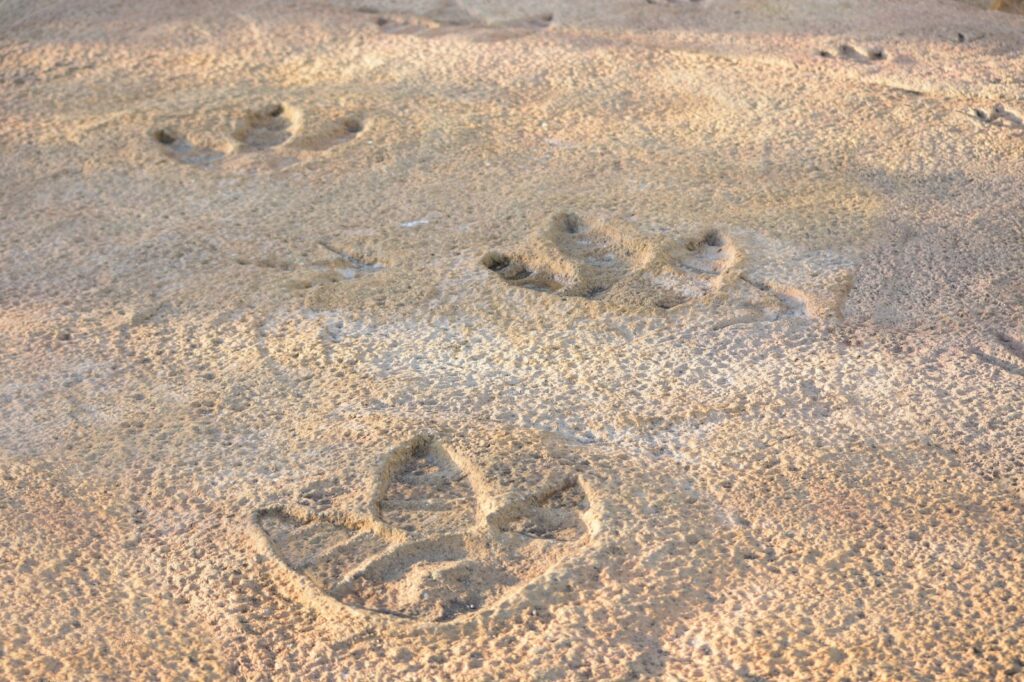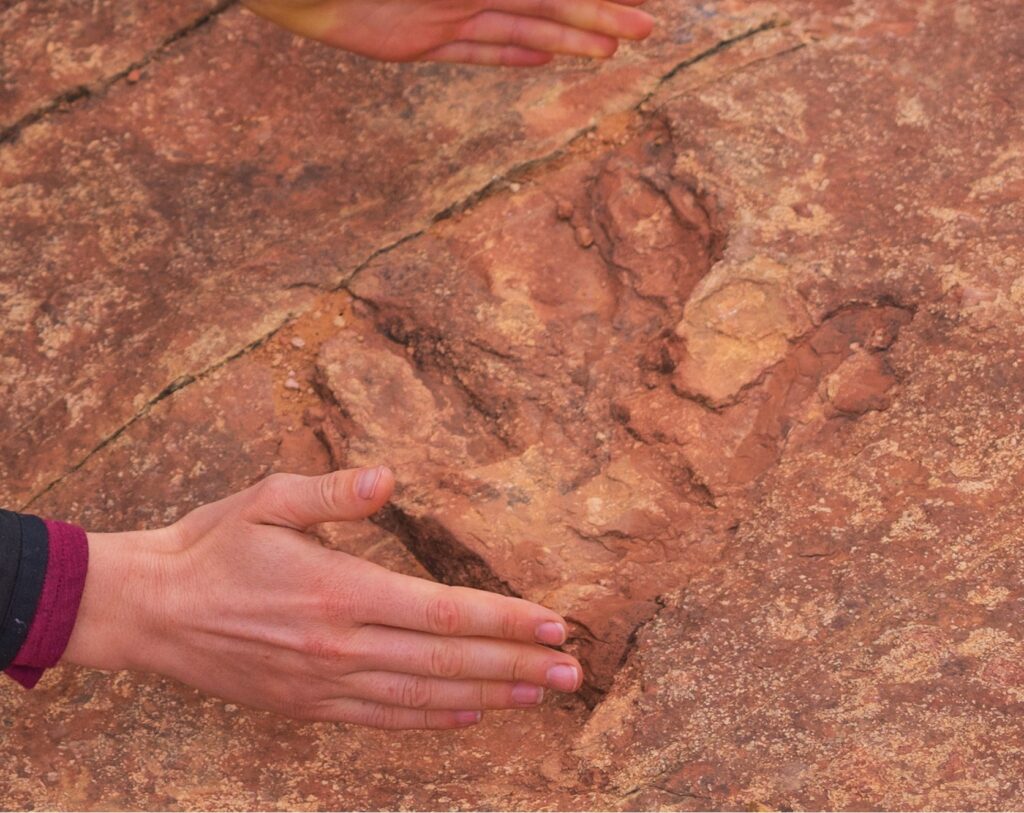The allure of dinosaurs has captivated our imaginations for centuries. These ancient creatures, although long extinct, left behind remarkable traces of their existence: dinosaur tracks.
Discovering and witnessing real dinosaur tracks allows us to connect with the prehistoric world, providing invaluable insights into their behavior, anatomy, and habitat.
In this article, we will delve into the wonders of dinosaur tracks, explore their formation, and highlight several remarkable locations around the world where you can see these tangible remnants of an ancient era.
Importance of Dinosaur Tracks
Dinosaur tracks hold immense scientific and historical value. They offer a unique window into the past, providing evidence of the presence, movement, and social behavior of dinosaurs. By studying these tracks, paleontologists can gather information about the size, stride, and species of dinosaurs that once roamed the Earth.

Moreover, these footprints shed light on their environment, such as the types of landscapes and ecosystems they inhabited. The study of dinosaur tracks contributes to our understanding of Earth’s history and the evolution of life.
Formation of Dinosaur Tracks
Dinosaur tracks are formed through a series of geological processes. It begins when a dinosaur walks on a soft, muddy substrate, such as wet sand or clay. The weight and movement of the dinosaur create depressions in the substrate, leaving behind impressions of their feet.
Over time, sediment accumulates in these depressions, eventually hardening into rock. As erosion occurs, the rock layer containing the footprints may be exposed, revealing the preserved dinosaur tracks.
Famous Sites
There are several renowned locations around the world that offer incredible opportunities to witness real dinosaur tracks.
From the Paleontological Site of Enciso in La Rioja, Spain, to the captivating Dinosaur Valley State Park in Texas, these famous sites allow visitors to explore and marvel at the ancient footprints left behind by these magnificent creatures, providing a tangible connection to our prehistoric past.
La Rioja, Spain
La Rioja, located in northern Spain, is renowned for its impressive dinosaur trackways. This region boasts an extraordinary concentration of dinosaur footprints, particularly in the village of Enciso.

The footprints date back to the Early Cretaceous period and provide a glimpse into the dinosaur diversity of that time. Visitors can explore the Paleontological Site of Enciso, where guided tours offer insights into the tracks and the creatures that made them.
Dinosaur Valley State Park, Texas
Dinosaur Valley State Park, situated in Glen Rose, Texas, is a haven for dinosaur enthusiasts. The park is home to well-preserved dinosaur tracks, including those of sauropods and theropods. The Paluxy Riverbed within the park unveils a remarkable display of these ancient footprints.

Visitors can follow designated trails, marvel at the imprints left by these colossal creatures, and even wade through the river to get a closer look at the tracks.
Isle of Skye, Scotland
The scenic Isle of Skye in Scotland is not only renowned for its breathtaking landscapes but also for its dinosaur tracks. Along the coastline, near the village of Staffin, you can find fossilized dinosaur footprints imprinted in the rock formations.

These tracks belong to herbivorous dinosaurs that roamed the area millions of years ago. The Trotternish Peninsula is a popular spot to witness these remarkable traces of the past.
Dinosaur Ridge, Colorado
Dinosaur Ridge, located near Morrison, Colorado, offers a captivating journey through time. This site showcases an array of dinosaur tracks, including footprints from carnivorous theropods.

Guided tours provide visitors with fascinating insights into the lives of these ancient creatures. In addition to tracks, visitors can also marvel at fossilized bones, remnants of the prehistoric world that once thrived in this region.
Australia’s Dinosaur Trail
Australia’s Dinosaur Trail, spanning across Queensland, provides a unique opportunity to explore the country’s rich dinosaur heritage. The trail connects several locations, including Winton, Richmond, and Hughenden, where significant dinosaur track sites have been discovered.

Along the trail, visitors can witness well-preserved tracks, visit museums showcasing fossilized remains, and participate in guided tours to learn about Australia’s prehistoric past.
Research Efforts
Scientists and researchers worldwide actively study dinosaur tracks to deepen our understanding of these magnificent creatures. Through detailed analysis of track morphology, trackway patterns, and track preservation, scientists can gather valuable information about dinosaur locomotion, behavior, and group dynamics.
These studies contribute to the growing body of knowledge about dinosaurs and their world.
Preservation
Preserving dinosaur tracks is of paramount importance to ensure their longevity and accessibility for future generations. Measures such as site protection, controlled access, and careful monitoring help safeguard these fragile remnants of the past.
Collaboration between scientists, landowners, and local communities is crucial in preserving these invaluable traces of Earth’s history.
Education
Dinosaur tracks offer exceptional educational opportunities for people of all ages. Museums, visitor centers, and educational institutions often organize exhibits, workshops, and interactive programs to engage the public in the wonders of dinosaur tracks.
These initiatives aim to inspire curiosity, ignite a passion for paleontology, and foster a deeper appreciation for the natural world.
Guided Tours
For an enriching experience, joining guided tours led by knowledgeable experts is highly recommended. These tours provide in-depth explanations, interesting anecdotes, and a chance to explore dinosaur track sites with the guidance of experienced professionals.
It offers a unique opportunity to learn about the history, geology, and biology associated with dinosaur tracks while ensuring a safe and informative visit.
Safety Tips
While visiting sites with real dinosaur tracks, it’s essential to prioritize safety. Here are a few tips to consider:
- Follow designated paths and trails to avoid damaging the tracks or surrounding areas.
- Adhere to any rules or regulations set by the site management for the protection of the tracks.
- Respect the environment and wildlife by not littering or disturbing natural habitats.
- Wear appropriate footwear and clothing for outdoor exploration.
- Stay hydrated and carry necessary supplies, such as sunscreen and insect repellent, especially in remote locations.
Conclusion
Real dinosaur tracks provide a tangible connection to the ancient world, allowing us to envision the footsteps of long-extinct creatures. The exploration of these remarkable remnants offers insights into the lives
of dinosaurs, their behavior, and the ecosystems they inhabited. From the fossil-rich landscapes of La Rioja in Spain to the captivating Dinosaur Valley State Park in Texas, and the rugged coastlines of the Isle of Skye in Scotland, there are numerous locations around the world where you can witness these awe-inspiring tracks firsthand.

By studying and preserving dinosaur tracks, scientists continue to unravel the mysteries of the past, deepening our knowledge of Earth’s history and the incredible diversity of life that once existed. Educational initiatives and guided tours provide opportunities for people to engage with these fascinating remnants, igniting a sense of wonder and curiosity about our prehistoric past.
So, if you’ve ever wondered, “Where can I see real dinosaur tracks?” the answer lies in the remarkable sites scattered across the globe. Embark on a journey through time and immerse yourself in the wonders of these ancient footprints, connecting with a world long gone but forever imprinted in stone.
FAQs
- Are dinosaur tracks rare to find?
While dinosaur tracks are not as common as fossils, there are several locations around the world where well-preserved tracks have been discovered. These sites offer unique opportunities to witness real dinosaur tracks. - Can anyone visit sites with dinosaur tracks?
Yes, many sites with dinosaur tracks are open to the public. However, it’s important to follow any guidelines or restrictions set by the site management to ensure the protection and preservation of the tracks. - Are dinosaur tracks always found in open-air locations?
No, dinosaur tracks can be found in a variety of environments. Some tracks are exposed in open-air locations, while others may be discovered within caves or preserved in sedimentary rock layers. - Do dinosaur tracks provide information about specific dinosaur species?
Yes, dinosaur tracks can provide valuable information about the size, shape, and locomotion of various dinosaur species. Paleontologists analyze track morphology to make inferences about the dinosaurs that made them. - Can I make my own casts of dinosaur tracks?
In some cases, it may be possible to make casts of dinosaur tracks under the supervision of experts. However, it’s essential to obtain proper permits and follow ethical guidelines to avoid any damage or disturbance to the tracks.
